 |
Affiliated with the Canadian Slav Committee - Home of Slavic Values and Perspectives...
The Slavic Ethnogenesis
Identifying the Slavic Stock and Origins of the Slavs
Compiled by Andrzej Borzyskowski
This web page was an information resource I created for myself when I was active on Slavic culture forums and working on my animated Slavic historical films for my university Honours Project. This page contains information from a wide variety of sources with some personal opinions. Of course some of the information is arguable and speculative (just like all early Slavic history). I first placed this page online at the beginning of 2003. At one stage I was thinking of removing it as it's a little rough, and it's not even referenced properly. But I decided to keep it online as there aren't that many early Slavic history websites out there. To my surprise it has also proved to be quite popular with a decent number of hits and e-mail queries.
For information about my animated Slavic historical films and other works, please visit the website listed below:
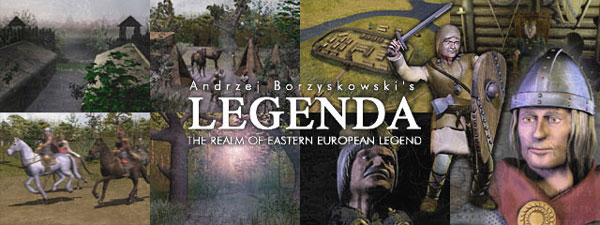
| Website URL: | http://www.andrzejb.net |
|---|---|
| E-Mail: | info@andrzejb.net |
At one stage I was intending to complete a revised, properly referenced version of this web page, that was going to be included in the appendices section of my university Honours dissertation - since the themes of my animated films had a lot to do with the information on this page. Unfortunately due to time constraints this did not happen and I instead opted to write a very brief overview on the Slavs for the dissertation appendices. Here is a short example of what the improved text would have looked like:
Study of the early Slavs has always been one of the most important topics in Eastern European historiography. Investigating the origins of the Slavs can be performed by conducting research in the areas of; linguistics, etymology, onomastics, ethnology, archaeology, anthropology, history and folkloristics explains Sedov (1994). Only cooperation between these various disciplines can solve the problem of the origins of the Slavs. Sedov (1994) and Curta (2001) both specifically mention linguistics and archaeology in particular.
Of these two particular disciplines, the most useful is linguistic palaeontology focusing on the early languages of a people, and studying physical archaeological artefacts, especially considering that the historical ethnic boundaries of peoples were marked by items of material culture. In the area of origins of the Slavs, linguistics and archaeology has commonly been used hand in hand, more often that not, archaeology was used to illustrate conclusions already drawn from the analysis of the linguistic material.
Ethnicity. 'No other term in the whole field of Social Studies is more ambiguous, yet more potent' (Curta 2001, p. 14). Throughout the ages 'ethnicity' has meant many things. In context of the origins of peoples one can view the meaning in this light; individuals are born with ethnicity, and are linked to it though cultural constructions of biology. It is far deeper than mere cultural difference as Curta suggests (2001, p. 15).
The first historical sources about the early Slavs were Roman, Byzantine, Greek, and later Germanic authors. Some early sources, indeed eyewitnesses, knew about the first Slavs and partially intuited the importance they would have for the known world. These included figures such as the lst century Roman historian Pliny the Elder, who was around at a time when the Roman Empire was at the height of its power. He was a contemporary to Nero (23 - 79 AD), who was known for his work Natural History, in which he described the early Slavs, the Baltic coast, and the fruitful amber trade to the Mediterranean.
'In his Natural History, Pliny the Elder describes the expedition of a Roman merchant sent by patrons of Circus Games to the Baltic region in search of amber, highly praised for its ornamental value. This Roman merchant travelled the length of the Baltic coast and brought back to Rome so much amber that a piece of it was inserted in every mesh of the netting which protected the public from wild animals in the arena. The largest piece is said to have weighed four kilograms' (Siuchninski 1979, p. 10).
Pliny the Elder was the first to refer to the tribes living along the Vistula river beside the Sarmatians and others, by the name Wend, or Venedi, the oldest known designation and first certain reference of the Slavs. Another notable early source from this period is the Roman historian Tacitus (55 - 120 AD) who says the same. 'He describes the Wends somewhat more in detail but cannot make up his mind whether he ought to include them among the Germans or the Sarmatians; still they seem to him to be more closely connected with the first named than with the latter' (Lenard 1912).
Information about the documentary series 'The Slavs'
Many of the images displayed on this web page are from the documentary series The Slavs (1984), directed by Folco Quilici. All images are used for educational purposes only.
From time to time I receive e-mails from people asking about the documentary series. Unfortunately the series is not commercially available and it does not exist anywhere online. It was broadcast on the ABC television network in Australia in the mid 1980s (when I was about 5 years old) and fortunately my father taped all 8 episodes that were aired. In 2009 I was contacted by the University of Virginia in the United States and with the permission of the director Folco Quilici I provided copies to the university for their Slavic Studies courses. Luckily the director replied as in previous years he had been unresponsive to e-mails about the series. It is a very rare documentary series and even the original production companies and director himself did not have copies. As part of the agreement I provided copies to the director. I have thought about uploading the series on YouTube however I have not requested permission to do this but one day it may happen.
The entities involved in the creation of the documentary series are the original production companies and copyright owners who are RAI (Italy) and ITC Entertainment (UK) (now owned by ITV) and Bulgaria Television. The University of Virginia and myself had correspondence with these entities when the university wished to acquire the series however these entities no longer have the documentary series in their archives and it is officially 'lost'. As I receive e-mails asking me what the documentary is like I decided to provide the opening sequence of the documentary under the fair use doctrine. This video clip is an excerpt of the first episode of the documentary and is intended to be used for educational purposes only.
The following is information about the documentary series from the Folco Quilici website: http://www.folcoquilici.com/en/serietv.html
CIVILTA' SLAVA (1976-1984) L'epoca di grandi migratori dell'Est e la complessa vicenda del loro insediamento in Europa. Dieci episodi di 26 minuti distribuiti nel mondo in lingua inglese dalla I.T.V. di Londra e mai trasmessi in Italia.
English translation from Italian (using online translator):
SLAVIC CIVILIZATION (1976-1984) The era of the great migration of the East and the complex history of their settlement in Europe. Ten episodes of 26 minutes distributed worldwide in English from I.T.V. London and never broadcast in Italy.
From the above information it seems that there are 10 episodes altogether, though I only have 8 - which was the number of episodes broadcast on the ABC television network in Australia back in the mid 1980s. In the early 2000s, I also made a transcript of the series for research purposes. Below is some information about the series and the episodes:
- I.T.C. Entertainment Limited
- R.A.I.-Radiotelevisione Italiana Rete 1
- Bulgaria Television
- Present
- A programme by Folco Quilici
- THE SLAVS
- Copyright © I.T.C. Entertainment Limited MCMLXXXIV
- Photography by Riccardo Grassetti
- Original music by Stefan Ribarov
- Directed by Folco Quilici
- with the collaboration of Mihail Atanassov Stoikov
- Historical Advisors
- Gino Arnaldi
- Boian Biolcev
- Mario Bussagli
- A Moana-Roma Production
- From ITC Entertainment
- Language: English
- Episode 1: The Slavs
- Episode 2: Slavic Beliefs, Rituals and Festivities
- Episode 3: Exoduses, Migrations and Conquests
- Episode 4: Cyril and Methodius and the Birth of an Alphabet
- Episode 5: Times of Change and Hardship
- Episode 6: Slavic Fortified Towns
- Episode 7: Slavic Arts and Religion
- Episode 8: The Slavic Bastion as the Bulwark of Europe
I have received various requests to make the complete documentary series available therefore for now I have decided to provide some complete episodes including transcripts which are available through the above links. The episodes are intended to be used for educational purposes only.
The Slavic Ethnogenesis: Identifying the Slavic Stock and Origins of the Slavs
- 1.0 Indo-European Ethnographic Colonisation of Europe
- 2.0 Slavic Ethnographic Colonisation of Eastern Europe
- 2.1 Study of the Origins of the Slavs
- 2.2 Early Historical Sources
- 2.3 The Slavic Cradle and Source of the Slavic Stock
- 2.4 Linguistic Studies and The Original Homeland of the Slavs
- 2.5 Early Life and Initial Migrations of the Slavs
- 2.6 The Great Slavic Mass-Migrations
- 2.7 The Formation of the Various Slavic Languages
- 2.8 The Great Slavic Mass-Migrations in History and Culture
- 2.9 The Slavs Post Mass-Migration
- 3.0 Selected Bibliography and References
1.0 Indo-European Ethnographic Colonisation of Europe

 |
| Map showing the distinct peoples that arose from the Indo-European migration westwards to Europe.
Above map from the book The Times Concise Atlas of World History.
|
|---|
From 6000BC to around 2000 BC, Europe gave rise to a secondary homeland of the Indo-Europeans that moved westwards, creating Celtic, Germanic, Italic, Greek, Balto-Slavic, and other European branches. Linguistic studies suggest that the Balto-Slavic branch then separated into separate Baltic and Slavic groups shortly thereafter (the closest relatives to the Slavs are the Baltic peoples of present day Lithuania and Latvia).
Over a few thousand years, the various Indo-European branches became significantly differentiated from one another in many respects.
Meanwhile, migrations to the south and east produced the various Indo-European languages and peoples of India, Persia and Asia Minor. The south and eastward travelling Indo-Europeans also no doubt encountered indigenous tribes.
At this time in history, Europe was originally inhabited by indigenous matriarchal agrarian tribes. They worshipped 'Mother Earth', and spoke unknown languages. Some of these peoples were most probably absorbed by the Indo-Europeans.
Indo-Europeans on the other hand were patriarchal and had a Pantheon of nature gods, the chief of whom was 'Father Sky'. The proto-language spoken by the Indo-Europeans was Proto-Indo-European, which is the ancestor of the Indo-European languages of today, as well as many extinct languages.
Some prominent scholars on the origins of the Indo-Europeans, is Lithuanian-born American Marija Gimbautas and British archaeologist Colin Renfrew. One possible homeland of the Indo-Europeans mentioned in research work, among several others, is Anatolia, one of the original homes of agriculture beginning 8000 BC.
The expansion of the Indo-Europeans from their original homeland was probably one of a slowly growing population of farmers rather than that of military conquests and deliberate migrations, leaving behind archaeological relics and artefacts such as pottery trails as they moved.
'Footsteps' of the Indo-Europeans - West Migrating Indo-European Archaeological Pottery Trails:
- - Early painted ware cultures (Greece and Crete)
- - Ware cultures (Balkans)
- - Balkan painted and impressed (Balkans/South-East Europe)
- - Danubian linear incised pottery cultures (East/Central/West Europe)
- - Impressed ware cultures (France and Spain)
- - Bowl cultures (France and British Isles)
2.0 Slavic Ethnographic Colonisation of Eastern Europe
2.1 Study of the Origins of the Slavs
Study of the early Slavs has always been one of the most important topics in Eastern European historiography. Investigating the origins of the Slavs can be performed by conducting comparative research in the areas of history, linguistics and archaeology. Of the latter two, the most useful are 'linguistic palaeontology' and studying physical archaeological artefacts, especially considering that the historical ethnic boundaries of peoples were marked by items of material culture. In the area of Slavic origins, linguistics and archaeology are commonly used hand in hand, more often than not, archaeology was used to illustrate conclusions already drawn from the analysis of the linguistic material.
Ethnicity. No other term in the whole field of Social Studies is more ambiguous, yet more potent. Throughout the ages it has meant many things. In context of the origins of peoples one can view the meaning in this light; Individuals are born with ethnicity, and are linked to it though cultural constructions of biology. It is far deeper than mere 'cultural difference', as acclaimed Slavic antiquity researcher Florin Curta (2001) suggests.
2.2 Early Historical Sources
The historical sources about the early Slavs are classified into three categories according to the position of their authors: eyewitness, possible contact and second-hand information. Some early sources, indeed eyewitnesses, knew about the first Slavs and partially intuited the importance they would have for the known world. These included figures such as the Roman historian Pliny the Elder, contemporary to Nero (23 - 79 AD), who was known for his work Natural History, in which he described the early Slavs, the Baltic coast, and the amber trade to the Mediterranean.
 |
| Image from the documentary film The Slavs (1984).
|
|---|
In his Guide to Geography, 2nd century Greek astronomer and geographer Ptolemy, mentioned Calisia (Kalisz). At the time it was probably an important settlement on the Amber Trail that linked the Adriatic with the Baltic coast. The course followed by this route has been established from finds which contained objects of Roman provenance, such as bronze pitchers, pails, pots and pans, glass cups, silver coins and figurines. Another early source from this period is Tacitus (55 - 120 AD).
Sources during and after the mass-migration include Jordanes, a Goth historian of the 6th century known for his work Getica, and an anonymous chronicler who is known as 'The Bavarian Geographer'. More to do with the origins of Poland and Polish history, but also describing the early Slavs are Ibrahim ibn Jakub, a 10th century scribe and Moorish Jew slaver from Tortosa in Spain.
The writer of the first ever chronicle of Poland was the 'The Anonymous Gaul', named Gallus Anonymus of the 12th century. He was a French Benedictine monk, and wrote the chronicle for Polish king Bolesław III Krzywousty. Here is a passage from his precious work describing the country of Poland: "A land where the air is healthy, the ground is fertile, the waters team with fish, and the men are warriors." He also documented two narratives concerning the Polanian tribe of Wielkopolska and the origin of the Piasts.
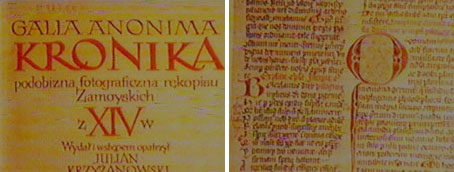 |
| Images from the documentary film The Slavs (1984). |
|---|
Wincenty Kadłubek, the Bishop of Kraków (1150 - 1223 AD), was the first native chronicler of Poland. "The Romans never conquered Poland", a source of pride to Kabłubek (2001, Lukowski & Zawadzki). He also acknowledged and documented the Slavic peoples mass-migrations from their ancestral homeland in his version of the Lech, Czech & Rus epic narrative, and mentioned stories concerning the Wistulans of Małopolska.
Jan Długosz (1415 - 1480 AD) was a significant Polish political and religious figure, historian and chronicler in medieval Slavic and Eastern European history. He wrote his great chronicle Annales seu cronicae incliti regni Poloniae in Latin or The Annals of Jan Długosz, in the later years of his life. It is described as a contemporary history of the half-forgotten lands between the rivers Oder and Dnieper: Byelorus, Bohemia, Hungary, Lithuania, Poland and the Ukraine from 965 to 1480 AD.
He describes the various Slavic peoples and origins of Polish statehood including the Polanians in Wielkopolska. Other sources are Greek and Roman historians such as the Greek Prokopije and Byzantine figures such as Constantine Porphyrogenitus, and countless other historians and chroniclers, of both Slavic and non-Slavic origin.
All of these eyewitnesses had one thing in common; they thought of the Slavs as a separate people, differentiating from the other peoples in Europe. Different not just in language and culture, but also physical appearance, attitude and temperament.
2.3 The Slavic Cradle and Source of the Slavic Stock
The "Slavic tribe" was and is part of the Indo-European family, and as consequence, the antiquity of the Slavs goes beyond the time of their first mention by historical sources, for "all modern nations must have had ancestors in the ancient world" - Czech historian Safarik, All-Slavic Conference, Prague (Curta 2001, p. 7).
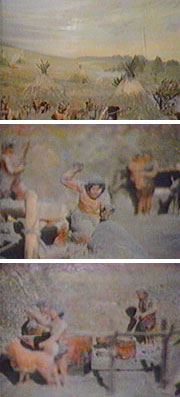
By about 1500 BC, the area of land which now corresponds with south-eastern Poland and north-eastern Ukraine became home of the early Slavic tribes, which are commonly known as the Proto-Slavs. Studies and excavations of this area of land, that could be called the 'Slavic Cradle', prove that the present day Slavs are the descendants of these tribes. The Proto-Slavic tribes dwelt in their homeland for many centuries, speaking one common language; which in time would produce the modern Slavic languages of today as well as extinct languages.
In my opinion, taking into account the history of the various other peoples of Europe, based on historical evidence and observation, I believe that the physical appearance of Slavic peoples are generally discernible from non-Slavic peoples. For me there is a general 'Slavic look' as Slavs do share certain physical characteristics that are more common amongst Slavs more so than non-Slavs. For example if you were to place Slavic persons of any nation in a room full of non-Slavic European persons, you would have quite a good idea who was a Slav or non-Slav.
Models displayed in a Ukranian museum of what an early Proto-Slavic settlement would have looked like nearly 4000 years ago. Images from the documentary film The Slavs (1984).
The Slavs of today are the branches of the Slavic tree that was sprouted from the seed of Proto-Slavic tribes who inhabited the 'Slavic Cradle'. Of course there are certain differences that developed between the three Slavic groups due to gradients occurring and branches intertwining with other peoples in and around the geographical regions in which they settled post mass-migration. Even though this is the case this does not eliminate the 'Slavic Stock'.
The Slavs are a distinct ethnographic and linguistic branch of Indo-European people in the same manner that the Germanic, Italic, Baltic, Celtic and other peoples are. Terminology differs, though if one is to use the word 'race' for labelling the different branches of Indo-European peoples e.g. 'the Germanic race', or 'the Celtic race', then one must label the Slavs in the same manner as well.
2.4 Linguistic Studies and The Original Homeland of the Slavs
The word 'Slav' or 'Slowianin' derives from the Slavic term for word; 'Slowo'. Thus, to the Slavs their name testified to their mastery over spoken words. It could be put as 'the ones we understand'. The Slavs called themselves 'Slovjeni' or 'Slaveni' do to the fact that their people 'understood' one another. Their neighbours to the west, in particular the Germans who spoke a different tongue, were not understood, and thus the Slavs came to call them 'Nijemcima' meaning mutes, dumb, speechless and silent. It could be put as 'the ones we do not understand'. The name has stood the test of time; Germans are still called 'Niemci' today by the Slavic peoples.
Language is "the defining factor in the formation of a particular culture type and world view" - Herder.
In 1833, the Slavic languages were identified and categorised as an Indo-European language by linguists. Language and ethnicity go hand in hand, as language is one of the quintessential aspects of ethnicity. The Proto-Slavs spoke the same language of Proto-Slavic, which later evolved, from the result of latter migratory separation of the Slavic people, into the Slavic languages of today.
 |
| Image from the documentary film The Slavs (1984). |
|---|
One way of determining where the original homeland of the Slavs is to undertake linguistic palaeontology. Polish botanist J. Rostafinski for example, pushed linguistic evidence even further. He argued that the original homeland of the Slavs was devoid of beech, larch and yew trees, because in all Slavic languages, the words for those trees are all foreign loan words of Germanic origin. On the basis of distribution of those trees, Rostafinski was able to locate the ancestral homeland of the Slavs in the marshes along the Pripet River in Polesie, generally in the south-eastern Poland and north-eastern Ukraine area, as this area was devoid of such trees. Polish historian Jan Peisker, elaborated this view stating "the Slav was the son and product of the marsh" (Curta 2001, p. 8).
 |
| Images from the documentary film The Slavs (1984). |
|---|
2.5 Early Life and Initial Migrations of the Slavs
During the years 1500 BC to 100 AD (before the great mass-migrations), the Proto-Slavs began their first minor migrations, most of it in their own Slavic cradle. It was the hostile environment of the Pripet marshes that forced the Slavs to migrate in all directions at this early stage. The experts refer to the Proto-Slavs as nomadic peasants who practised primitive forms of agriculture. They were also hunters who pursued herds of prey for months. Hunting expeditions called for tenacity and courage and the use of every possible kind of weapon or trap.
As the early Slavs were agriculturalists, their migration at this stage was not one of violent conquest by warriors, but of peaceful colonization by peasants moving about with tents in family groups. The early Slavs of the Slavic cradle also had a deep sense of religion, even though it involved pagan nature worship and ritual sacrifices.
Significant Czech historian and endorser of Rostafinski's work, Lubor Niederle, believed that both climate and soil, shaped civilization. Since the natural conditions of the Pripet Marshes were unfavourable, the early Slavs developed forms of social organization based on co-operation between large families (zadruga), social equality, and the democracy which curtailed any attempts at centralization of economic or political power. The harsh climate of the Pripet marshes also was responsible in forcing the Slavs into a poor level of civilization (Curta 2001, p. 9), compared to the other peoples of early Europe.
 |
| Images from the documentary film The Slavs (1984). |
|---|
One of the Proto-Slavic cultures in this early period was the Lusation culture of the Proto-Slavs, which began to take shape in the 13th century BC, in the regions of Lusatia, Silesia, and Wielkopolska, gradually spreading in every direction. Archaeological evidence such as these old funerary earns (pictured below), and one the great early Slavic achievements; the fortified village of Biskupin (450 BC) can be attributed to this culture of the Proto-Slavs, which peaked in the 7th and 6th centuries BC.
 |
| Images from the documentary film The Slavs (1984). |
|---|
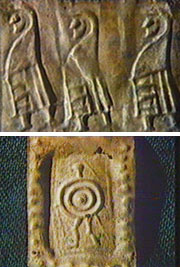 |
| Images from the documentary film The Slavs (1984). |
|---|
From what I can gather the furthest migration the Slavs undertook in this early migratory period were Ptolumy's version of the 'Venedi' Slavs, which migrated south and settled in Italy. It is important to note that the earlier Venedi as described by early eyewitnesses such as Ptolemy was different than that of Jordanes' 'Venedi' Slavs. Over a long period of time, Ptolumy's Venedi Slavs had filtered through the passes of the eastern alps. They made their way as if with the instinct of migratory birds down towards the Po valley and finally settled in an extremely fertile and more favourable climate, which still bears the name derived from theirs, the Veneto region of Italy.
The early Slavs who came south, had the skills needed to make these bronze plaques (pictured to the left) in the 6th and 5th centuries BC. Over the centuries however they merged with the native population and slowly lost their own identity, taking on the cultural characteristics of neighbouring peoples, such as the alphabet which they probably learned from the Estruscans. Because of this process of evolution, the Venedi grew increasingly differentiated from their north-eastern cousins, who also in their turn refined their skills in working materials, casting objects in metal for instance (1984, Quilici).
Above all wood was the material most commonly used by these men of north-eastern Europe. They used tree trunks for their houses, for making agricultural tools and for fashioning the boats they needed to travel on the many waterways that abounded in there untamed world. For months on end, every winter, those inland waterways and expanses were transformed by ice and snow. In the hostile season the early Slavs lived out their dark and silent odysseys in a desperate struggle for survival. But, with the thaw, vigorously celebrated in the Slavic culture, life would again thrive (1984, Quilici).
 |
| Images from the documentary film The Slavs (1984). |
|---|
The Slavs were perhaps the quietest or 'purest' branch of Indo-Europeans, due to the fact that the Slavic tribes did not move around or mix with outside populations as much as other Indo-European groups of the same period. Of course, they encountered bands of marauders, such as the Iranic Scythians (who destroyed Biskupin around 400BC), but nothing that would cause them to shift and migrate. Compared to the Slavs, the other peoples moved greatly. For instance the Romans conquered western and central Europe, the whole of North Africa, the Near East and Britian, Germanic tribes like the Sueves reached Spain, and others reached Scandanavia, and Celts like the Picts and Scots reached the British Isles.
Whilst all this was happening, the Slavs stayed put in their ancestral homeland for over 2000 years. The reason for this is the fact that early Slavs were not faced with pressure to move from migrations of other peoples. It is true to say that the Slavs material and spiritual development was a lot slower and occurred much later than the other Indo-Europeans due to this 'isolation' and due to the harsh climate of the Pripet marshes, as described by Lubor Niederle.
2.6 The Great Slavic Mass-Migrations
In the 1st century (0-100 AD), the early Slavs were still situated around the 'Slavic Cradle', which now had expanded encompassing the Baltic to the Carpathians, as a result of the smaller, initial migrations from the Pripet Marshes. The Slavic word for glory; 'Slava' is originally a reference to the great and proud ancestral homeland. Indeed epic stories of the great mass-migration away from the Slavic cradle are embedded in the history and cultural heritage of the Slavs.
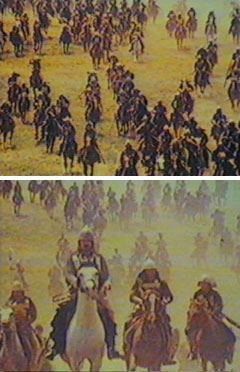 |
| Images from the documentary film The Slavs (1984). |
|---|
The great mass migration of the Slavs from the ancient homeland of the 'Slavic Cradle' to the west, east and south of Europe began around the end of the 2nd century AD and continued to the middle of the 7th century AD. The name Proto-Slav can be said for the Slavs before the mass-migrations, and the name Slav for the Slavs after the expansion. The mass migrations of the Slavs were instigated by the movements of other ethnic peoples; namely the Germanic tribes and Asian nomadic barbarians.
Firstly, the migration was to the west, peacefully and quietly, tribe after tribe, occupying districts and regions the Germanic tribes (e.g. Vandals, Visigoths and Ostrogoths) deserted in order to attack the Roman Empire. The waves of nomadic barbarians, originating from central Asia such as the Huns, who arrived in 370 AD, then pushed the Slavs in all directions following their advance. As the Hun empire fell in 453 AD, there was a rush of Slavic migration to the south towards the Black Sea and the mouth of the river Danube. Slavic warbands and groups broke through many defences with weapons in hand, throughout the lower Danube in the outer regions of the Byzantine Empire reaching the Balkans. The first known recording of this Slavic mass migration was in the year 493 AD.
 |
| Above map from the book The Times Concise Atlas of World History. |
|---|
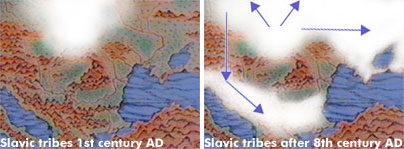 |
| Maps above illustrating the expansion of the Slavs from the 'Slavic Cradle'. |
|---|
 |
Red denotes, in no particular placement, various non-Slavic peoples of Indo-European and non Indo-European origin in which gradients have occurred with the Slavic stock and ethnographic mass, especially post mass-migration. |
|---|
In the 6th century, during the closing stages of the mass-migrations the Goth historian Jordanes and eyewitness wrote: "The Slavs are of one blood and live in three groups. The Venedic (West Slavs), Antic (East Slavs), and Sklavinian (South Slavs)" (2000, Pogonowski, p.19)."These are three great tribes of the same people."
2.7 The Formation of the Various Slavic Languages
The Proto-Slavic language was probably still common to all Slavs possibly as late as the 8th century AD, but by the 9th century AD, with the mass-migrations largely completed, the individual Slavic languages had begun to take place. But by the 9th century all the Slavic peoples could still understand each other well.
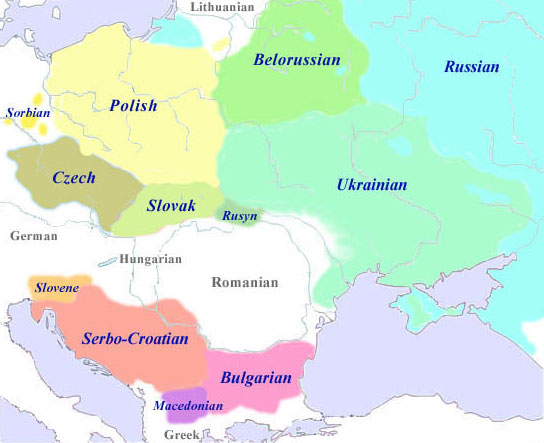 |
| Map from a now defunct website Indo-European Languages: http://www.geocities.com/indoeurop/atree.html |
|---|
The Slavic Languages
| West Slavic: | South Slavic: | East Slavic: |
|---|---|---|
|
|
|
2.8 The Great Slavic Mass-Migrations in History and Culture
The only Slavs that stayed put during the great mass-migrations are the Slovaks. This is the reason why they were, and indeed still are, situated almost in the centre of the Slavic cradle. Evidence of this fact can be seen in folkloristic studies. The Slovaks have no stories in their culture of their people shifting out of the ancestral homeland, unlike the Poles, Czechs and Croats etc. that have stories of such epic events.One example is Lech, Czech & Rus, which signifies the Slavic peoples migration away from the ancestral homeland. I must say don't dismiss legends as they can always be put in historical context, a certain chronological order in time and contain much factual information. Where not our Slavic forefathers trying to tell us something though the tales of migration they left behind for us? Also, it is said that one who speaks Slovakian, has the easiest time understanding the rest of the Slavic languages, as they are in the middle of the Slavic sea; one of the biggest 'human ethnographic seas', on the face of this earth.
Evidence of the South Slavs, in particular the Croats migrating from the ancestral home in Poland to Dalmatia is also recorded in folk narratives, and also in historical fact. The folk narrative describes five Slavic brothers and two sisters that lead the Croats from the area around Kraków in Poland into the Balkans in the 7th century. Are these epic tales of heroic migrations a coincidence? Not according to historical fact. It is interesting to note that it is historical fact that the first kingdom of Croatia, White Croatia, was not situated in Dalmatia but in Poland, Bohemia and Slovakia with its capital being Kraków. Indeed White Croatian figures played a pivotal role in early history of the Polish and Bohemian kingdoms. Even the first canonised patron saint of Poland, St. Wojciech; 'Wojciech of the Slavs' was a White Croatian.
2.9 The Slavs Post Mass-Migration
The Slavs evolved during the 6th century mass migrations from a 'segmentary society' with lack of hierarchy to a society ruled by chiefs who fought between them. The emergence of the political organization was the result of the contacts with the outside people, which had not happened to a very large degree up until that time.
When Charlemagne was crowned Holy Roman Emperor in the year 800 AD, he knew less about the area of land in which the Slavs dwelt than any other part of the European mainland. His Frankish and Saxon dominions ended on a line roughly equivalent to the recently defunct Iron Curtain, beyond which stretched a limitless Slav sea. The Slavs existed in a relative vacuum up until then. With the conversion of Christianity, the Slavs propelled their culture, consolidated their dominion, and began to take an active part in European history and politics. The Slavs were to play a crucial role in European history, their kingdoms were to act as a bulwark for the whole of Christendom and Europe.
3.0 Selected Bibliography and References
Barraclough, G. (ed) 1982, The Times Concise Atlas of World History, Angus & Robertson Publishers, London.
Curta, F. 2001, The Making of the Slavs: History and Archaeology of the Lower Danube Region c. 500 - 700, Cambridge Univerity Press, Cambridge.
Gasiorowski, P. 2002, Piotr Gasiorowski's Indo-European Page [Online], Available: http://www.geocities.com/Athens/Oracle/2190/Indo-European.html [2002, Apr. 8].
Gy, C.K. 2002, Central European Myths of Conquest [Online], Available: http://www.hhrf.org/minoritiesresearch/mr05.htm [2002, Mar. 11].
Lukowski, J., Zawadzki, H. 2001, A Concise History of Poland, Cambridge Univerity Press, Cambridge.
Pogonowski, I.C. 2000, Poland: An Illustrated History, Hippocrene Books, New York.
Siuchninski, M. 1979, An Illustrated History of Poland, Interpress, Warsaw.
Szczytna, L. 2002, Notes on Polish History [Online], Available: http://slavic.freeservers.com/Poland1.html [2002, Sep. 27].
Larousse Encyclopedia of Mythology 1959, Paul Hamlyn Limited, London.
The Slavs (video recording) 1984, ITC Entertainment, Directed by Folco Quilici.
2001, Early History of the Slavs [Online], Available: http://www.campuslife.utoronto.ca/groups/csa/croatia/history/slavs.html [2001, Aug. 29].
2002, Indo-European Languages [Online], Available: http://www.geocities.com/indoeurop/atree.html [2002, Apr. 4].